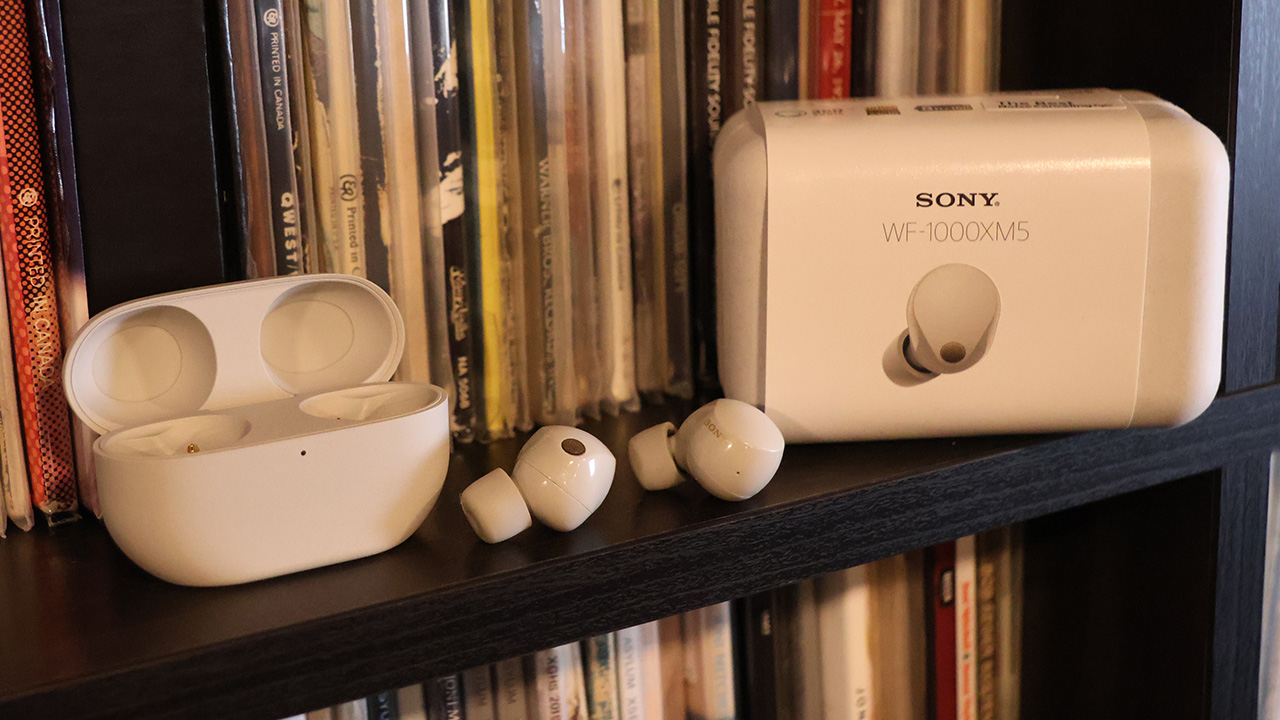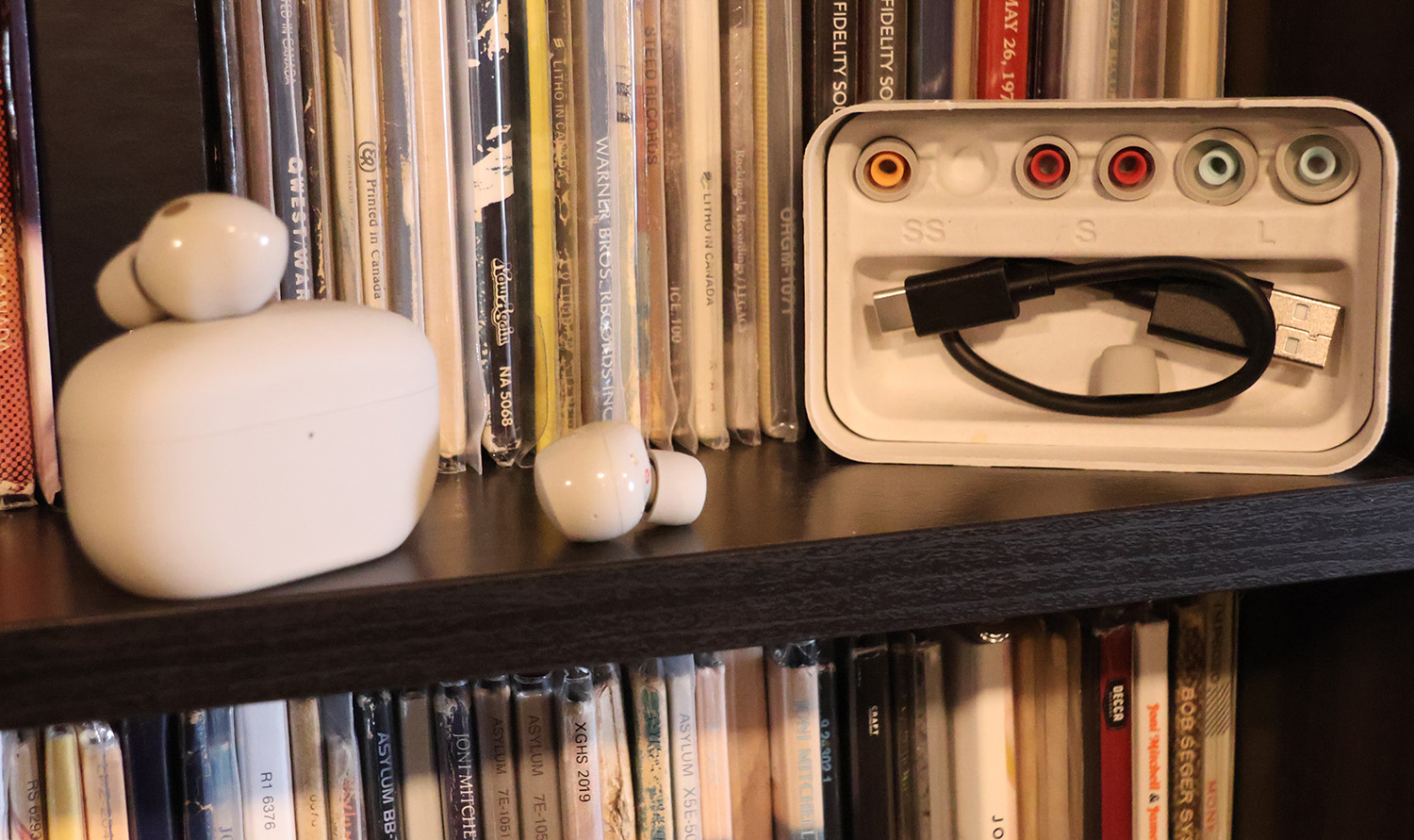
Sony’s WF-1000XM5 earphones are the follow up to the WF-1000XM4 model from a couple of years ago, which topped my list of best reviewed headphones. So I was very interested to see (and hear!) how this latest model performed. With a reduced form factor, changes to the underlying ANC technology and driver design, it was clear it wasn’t going to be just a small change. Do the Sony WF-1000XM5 earphones surpass the high performance of the previous model? Let’s find out!
Sony WF-1000XM5 specifications
- Bluetooth 5.3 (multipoint, LDAC, LE Audio)
- Weight: 5.9g (each) / Case: 39g
- 8.4mm dynamic drivers
- IPX4 water resistance
- Dual chip V2 ANC, redesigned foam earplugs for passive noise cancellation
- Battery: 8 hours with ANC (12 hours off), 3 min. quick charge for 60 min. runtime
- Wireless QI charging
- iOS/Android app for full control/customization
Design of the Sony WF-1000XM5 earphones

Unboxing
For those used to fancy unboxing experiences the unveiling of the Sony earphones can tend towards the underwhelming. Wrapped in effective yet pedestrian materials, the selling feature here is that it’s all recyclable, a small thing perhaps for a device without user-replaceable batteries at end-of-life, but every bit counts. Inside the thick paper case are the earbuds, a charging cable, replacement tips, and some documentation. Right away you’ll see it’s much a much slimmer package than its predecessor, the earbuds themselves some 20% lighter, and 25% smaller. The tips have been redesigned with a different foam blend, making for even better noise cancellation even with ANC disabled.
Design
The surface of much of the earbud is glossy, save for a section towards the bottom which serves as the touch control (features of which are customized in the iOS/Android app). The former model was more bulky, but I enjoyed the small mic protrusion that allowed adjusting without accidentally activating the touch controls. Still, given how they sit more comfortably nestled in the ear, there’s less need to futz to begin with.
The slippery surface does mean getting them out of the case is a bit more of a pain. I’ve found a couple ways of getting them out without drama, usually using my thumb to push to the side. It’s a small thing, of course, and I’d much rather have the super secure magnetic feature to prevent accidental exit than having to modify slightly how I extract. The case has a slight texture making it far less likely to slip from your hands, and the top cover is solid, closing with a satisfying snap. The USB port on the back has a reset button hidden beside it, and one of its beneficial features is to allow you to wireless charge easily and quickly.
Comfort
The comfort and fit of the XM5 earphones is exceptional—the bulkier WF-1000XM4 did feel a bit heavy in the ear, and when I’d replace them with the also excellent LinkBuds S, with their much more compact design, I felt the difference substantially. The WF-1000XM5 are only slightly bigger than the LinkBuds, but with performance that exceeds the prior XM4s with its larger form factor. The best of both worlds in one package makes for a very happy thing indeed.
Setting up the Sony WF-1000XM5 earphones

The setup for these earbuds was as painless as always, especially on Android where the quick-connect feature works pretty flawlessly. Out of the box the earphones allow for multi-point connection (this was a welcome addition to the 1000XM4 after release via firmware update), and the ANC and other settings will be familiar to users of the prior model. There are several new features on the 1000XM5, some more gimmicky and others absolutely foundational. The first is that touch controls can now be set to work with just about any feature—previously you had to select to control only two elements—volume, sound mode (ie., ANC), and track progression. Now you can set it with multiple taps/hold to control all three, a small but very welcome change.
Other features include head tracking for 360 degree audio. It took more effort than it should have been to calibrate on my Samsung, and despite saying it’s all setup it didn’t seem to behave the way I would have expected. Still, this isn’t a major feature for me, and no doubt it’s a mix of user error and the novelty of the tech that’s preventing from getting a “wow” factor here. No matter, I’ll go back to listening to the tracks in stereo like they were originally mixed, and save multi-channel experiences for my home theatre when I want to truly be bathed in sound.
You can take photos of your ears to analyze their shape, allowing streamers such as Tidal to be optimized for playback. Being able to quickly A/B optimized vs. non-optimized would be ideal, but I didn’t see much in the way of difference at least on my setup.
Equalization remains highly customizable, and with the new design I actually found dropping the “clear bass” to -1 made the sound open up even more. As someone weaned on the “MaxxBass” of 1980s Sony Walkmen, it’s somewhat amusing I’ve aged into dialing back the punch in favour of a superior musical experience.
The internal DAC uses 24bit, meaning that in theory you are getting processing signal even from what remains the choke point, namely the transmission standards for Bluetooth. LDAC is a boon, and definitely sounds significantly better, but when playing high resolution files you’re still being restricted by the maximum bitrate of the lossy Bluetooth transmission. This is the one major part of true-wireless earphones that need technology to catch up, and each year we get closer to the demands of audiophiles to be able to have the performance maximized while maintaining battery life.
Sony WF-1000XM5 audio quality
There are arguments to be made about making a model and sticking with it (my reference in-ear and over-the-ear headphones, for example, are models decades old and still being manufactured). Yet thanks to improvements in miniaturization, it seems we’re at a golden age of producing relatively inexpensive flagship true-wireless models that deliver performance that only a few years ago was reserved for professional models costing multiples more. The 1000XM4 was a class leading product, so I was half expecting more of the same, with minor improvements at best.
I was wrong.
While the earphone itself reduced in size, the driver inside actually increased quite dramatically, moving from around 6mm to 8.4mm. This produces not only more bass impact, but thanks to some clever sonic sculpting there are improvements in just about all frequencies. This is one of those fun things when comparing earphones back to back—the 1000XM4 have been my reference earbuds at this price range for over a year, and I’ve had literally hundreds of hours on them. They sounded great, and yet after listening on the 1000XM5 it was immediately evident that things were, simply put, better. Better bass, better imaging, better mid-range warmth, better clarity in the highs. My reference pair in this class were out referenced, and that’s a very fun thing to experience.
Imaging is excellent, and the performance from a wide range of frequencies from a wide range of sources is top notch. Setting Bluetooth to prioritize sound quality (and making sure LDAC is selected in my Bluetooth connection settings), I was treated to some stellar sound experiences.
I challenged things with the soundtrack to Spielberg’s “West Side Story”, the Overture providing both a dynamic and rhythmic workout, from the quiet intro to the explosive slam of the orchestra hit. I gave Coltrane’s “Giant Steps” a go via Tidal’s “Max” stream, and the impact of the drums, the tone of the sax, the muffled stabs of piano, and the insistent drum part were handled well.
I gave Renaissance’s “Northern Lights” a shot as well, an old favourite that’s hardly an audiophile showcase, but still a fitting test. Annie Haslam’s voice, bathed in reverb, nestled nicely within the track, and when the middle-eight opens up and the strings swell it’s a lovely experience, especially when the reed instruments come in to provide a capper.
Finally, I gave Kate Bush’s glorious “The Man with the Child in His Eyes” a chance, and between the crystalline vocal, the sawing cellos, the resonant grand piano, and the gentle hint of tape hiss, it was clear the WF-1000XM5 earphones were up to the task.
Noise cancelling
I have previously found that the Sony’s are, in general, class leaders when it comes to adopting ANC modes that don’t mess with the sound in egregious ways. With the 1000XM5 earphones there’s a very, very slight change in timbre when turning ANC on and off, but it’s basically imperceptible when switching back and forth. This model has made many improvements on the ANC front, and it seems to do a much better job in just about all frequencies, from the low rumble of a plane’s engine to the screaming baby I suffered sitting beside me during a recent 14-hour flight. Call quality has promised improvement, and certainly in quiet areas it’s as clean as speaking into the phone itself. Walking outside in the wind remains a challenge, but thanks to the more streamlined form factor, better microphone implementation, and the use of AI to focus on speech frequencies, these earphones do an excellent job on this front.
Final thoughts
I had already expressed plenty of love for the previous the Sony WF-1000XM4 model, and was suspicious we’d get such a jump forward with the latest model (frankly, in the past, improvements, even from this storied brand, aren’t always guaranteed). But after spending many hours fully immersed in the soundscape of the WF-1000XM5s I’m happy to be able to say that these are quite simply the best earphones in this price range, and easily deserving of “flagship” status within this space. With its robust features, exceptional audio performance, ease of use, newfound comfort and fit, the Sony WF-1000XM5 earphones deserve to be the top of list for anyone wanting to simply have a rock-solid solution for their in-ear audio needs.





